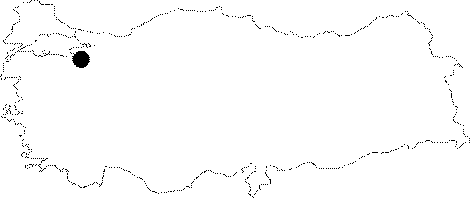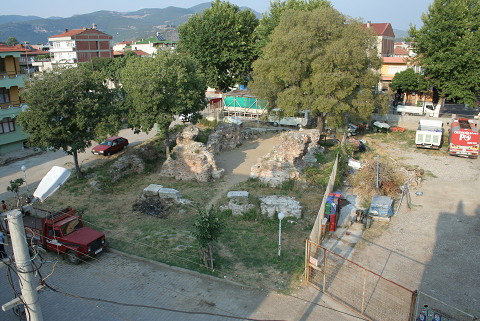| Location: The remains lie on the Atatürk Avenue in the Mustafa Kemal Pasa Quarter of the Iznik Disrict in Bursa. |
| Geography and Environment: The surroundings of the remains near the Istanbul Gate, which is one of the four gates piercing the Iznik fortifications have been cleaned, and converted into a park by the municipality. |
| Research and Excavation: During a survey conducted between 1932-38, A.M. Schneider saw only some wall remains of the building on a hill covered by bushes [Schneider 1943:18]. The building was revealed during the Iznik Tile Kiln Excavation that was performed by O. Aslanapa in the region in 1964 [Eyice 1983:153]. S. Eyice introduced the building by two of his publications [Eyice 1971; Eyice 1983]. |
| Description: Architectural Features: The remains belong to a church with a ciborion plan in the east-west direction. Various types of masonry is observed in the building; alternate courses as well as brick courses on one or two rows of large stone blocks. Framing technique is also observed at some spots [Eyice 1983:155; Otuken 1986:229]. The narthex was divided into three bays by two arches. The access into the naos was provided through three doors. The naos is a square building covered by a dome, approximately 6 m in diameter, standing on four wall buttresses. The naos is flanked by a corridor on the right and left sides. To the east of the naos is a bema with angles on the outside, and rounded on the inside. The lateral corridors, similarly, end with apses which are circular on the inside, and angles on the outside [Eyice 1983:154-155]. Almost half of the main apse was collapsed. The apse has a rounded form inside and it is assumed to have five corners outside [Eyice, 1983, 155]. The remains of a step is visible on the apse which has a depth approximately of 0.45-0.50 m, 0.30 m high. [Ermis, 2009, 125]. The small single step remain height observed in the apse is possibly the synthronona, of which the examples are rarely seen in early Byzantine period structures [Ermis, 2009, 325]. |
| Finds: Architectural Plastic: It is reported that the church remains included some architectural plastic elements in 1965 [Eyice 1983:156]. Other: Many mosaic fragments from the pavement and walls were found among the remains [Eyice 1983:156-157]. |
| Interpretation: K. Papadopoulos identified the church near the Istanbul Gate as St. Tryphon [Papadopoulos 1952:110-113]. On the other hand, S. Eyice claimed that the large church near the Yenisehir Kapi, housing rich mosaics finds, might have been the church of St. Tryphon [Eyice 1983:157-159]. U. Peschlow states that the various masonry techniques in the building suggest different construction phases [Peschlow 2004:210-211]. Although Eyice did not mention these different phases in one of the plans in his publication, he mentioned it in another one, but did not emphasize the differences in the text [Eyice 1988:21; Eyice 1983]. B. Yalman suggests that the large blocks of stones used in the lower section of the walls are from the theater nearby [Yalman 2002:116]. There are several opinions about the dating of the building. Schneider suggests the year 1000, Eyice the 13th century, and Peschlow somewhere between the 11th and 13th centuries [Schneider 1943:18; Eyice 1983:158; Peschlow 2004:212]. |
| Destruction: A major portion of the church was demolished. No remains that belong to the south nave could be observed. This area is being currently used as a parking lot. There is heavy destruction due to the road construction and housing development [TAYEx 25.07.2008]. |


